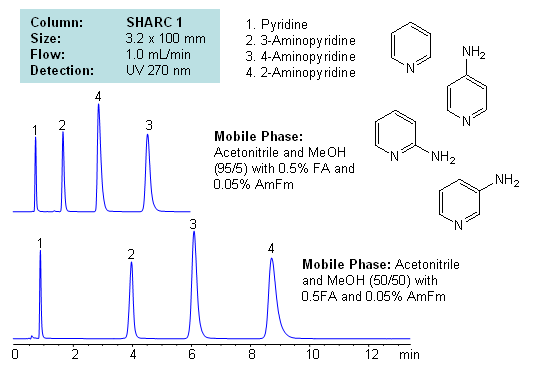
Application Notes: Pyridines and aminopyridines are hydrophilic basic compounds. Traditionally these compounds have been separated and analyzed by GC and HPLC. In the case of HPLC, reversed-phase chromatography with ion-pairing reagent is used along with alternative modes like HILIC for separation. Mixed-mode chromatography can also be used to successfully separate isomers of substituted pyridines. However, we developed a new mode of separation for these compounds with hydrogen bonding. Isomers of aminopyridine are separated based on hydrogen bonding interaction between analyte and stationary phase. Mobile phase utilizes combination of acetonitrile and methanol with additives. Retention time and selectivity are sensitive to variations of mobile phase. The order of elution changes depending on the amount of acetonitrile, methanol, formic acid and ammonium formate. This method and approach is compatible with LC/MS and prep chromatography and can be used for separation of other pyridine based compounds and pyridine based isomers.
Application Columns: SHARC 1, 3.2×100 mm, 5 um, 100A, To learn more about SHARC 1 columns click here. To order this column click here. To see more chromatographic separations check our web site.
Application Compounds: pyridine, 2-aminopyridine, 3-aminopyridine, 4-aminopyridine
Detection Technique: UV, LC/MS
| Column | Sharc 1, 3.2×100 mm, 5 µm, 100A |
| Mobile Phase | MeCN/MeOH |
| Buffer | Fa, AmFm |
| Flow Rate | 1.0 ml/min |
| Detection | UV, 270 nm |
| Class of Compounds |
Drug, Muscle strengthener, Hydrophilic, Ionizable, Vertebrate pesticide |
| Analyzing Compounds | 2-Aminopyridine, 3-Aminopyridine, 4-Aminopyridine, Pyridine |
Application Column
SHARC 1
The SHARC™ family of innovative columns represents the first commercially available columns primarily utilizing separation based on hydrogen bonding. SHARC stands for Specific Hydrogen-bond Adsorption Resolution Column. Hydrogen bonding involves an interaction or attraction between a bound hydrogen atom and molecules containing electronegative atoms, such as oxygen, nitrogen, and fluorine.
Select options3-Aminopyridine
4-Aminopyridine
Pyridine
UV Detection





